 Home
Home Up
Up Search
Search Mail
Mail
NEW
Measurements on Dutch passage mounds
(One of?) the first web pages on Dutch megalithic passage mounds
(since
beginning 1996)
An e-group
has been set-up to look into these Dutch monuments. It is at this
moment looking into the protection around the oldest monuments in The
Netherlands.
Orientation measurements
Orientation measurements were done on almost all of the Dutch passage
mounds.
From an overview and discussion on these results
one can see that most chamber of the Dutch passage mounds are oriented
along east and west.
Below a pictures is given of the number of passage mounds that have
a particular orientation (a comparable investigation has been done by Bom,
F. and see also Orientations
of the Dutch Hunebedden).

From this picture one can deduct that most chambers are oriented
between
246o and 305o (75% of measured passage mounds).
The
main declination will be between: -14o and 20o.
The
declination
is not really dependent on the altitude of the horizon, because in this
region of The Netherlands the horizon could be at maximum some 10 [m]
lower
than at the location of the passage mound (or the effect of trees had
to
be significant in the past).
Comparable orientations can be found on the German
passage mounds (of the same time frame, 3300 BCE to 2600 BCE, close
together [100 km], and comparable cultural environment [Funnel Beaker
Culture]).
Possible explanation for this distribution
The orientation of the Dutch passage mounds is around 270° +/-
25°
(or of course 90° +/- 25°).
I have the following theory that the deviation has to do with the
full
moon positions around equinox at building time of the mounds:
- The deviation of the Dutch passage mounds is around 270° or
90°,
so a relation with equinox (my definition of equinox is that sun sets
or
rises at 270° or 90°: around March 18th, 1999 AD)
could
have some significance
- The main reason why I think that it is not equinox that former
people
were
interested in, is because it is not a very interesting day in many
cultures.
Perhaps a full moon setting before or after equinox is much more
appropriate
for a rite!
- Furthermore and more important: I don't think it is equinox
itself,
because
there are clusters of mounds standing very close to each other (up to
three
within 50 m), which still vary in the orientation of the main axis by a
few degrees.
- Related to something like easter (Christian calendar)?
Easter Sunday is to be the first Sunday after the first full moon
after the 21th of March (spring equinox). If this full moon falls on a
Sunday, it is to be the following Sunday.
For calculations of Easter sunday; see here.
But I have the idea that the megalithic people also looked after
autumn equinox (or before spring equinox), because the
distribution
is not one sided around 270° or 90°. - Related to Harvest
Moon (full
moon closest to autumn equinox)?
- The altitude of the horizon could be of influence, but the height
differences
in the Netherlands are not very large (in Niedersachen,
where 53 mounds were measured, the horizon has more height
differences).
It could be that the height of the trees in the surroundings is
important...
Difficult to determine.
- The max. difference between sunset (or sunrise) azimuths some 29
days
(the
moon's orbit time) before and after equinox is around 2 * 17°.
If you include the max. moon set/rise difference due to its
inclination/perturbation,
the moon's azimuth before and after equinox can vary around 2 * 17°
+ 2 * 9° (at a latitude 53°) = 52°. In the below picture
the
moon's azimuth is determined from its actual (ephemeris) moon sets in
the
time period 29 days before/after equinox.
This 52° is thus comparable to the 2*25° measured orientation
of the passage mounds! - The question is, if we calculate the full
moon set (or rise)
azimuths around
equinox, do we get a comparable distribution of orientations as
actually
measured with the passage mounds?
Here is the distribution of calculated full moon setting between
1999-2092
AD (5 times the nodal cycle) before and after spring
equinox
(calculated with the help of the JPL's
HORIZONS ephemeris) and the distribution of the orientation of the
passage mounds in The Netherlands and Germany:
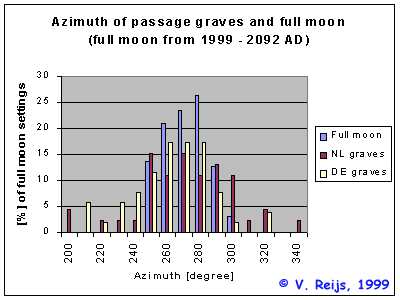
- The interval width of this distribution is 10°, because
according
to
normal statistical practice an interval should hold at least 5 to 10
sample
. Because the number of passage mounds in the Netherlands is 54, and
the
distribution spans some 60° (from 250° - 310°), the
interval
width should be at least 6°. So the chosen interval of 10°
seems
to be oke.
This interval value will thus obscure any perturbation/etc. effects
of the moon's orbit and also most inaccuracies of the measured
orientation
(1 sigma around 1°).
- The distributions look comparable, but if using the Kolmogorov-Smirnov
test (Dn*) it looks as if the orientations of the NL and DE passage
mounds don't have the same distribution as the azimuths of the full
moon
setting around equinox.
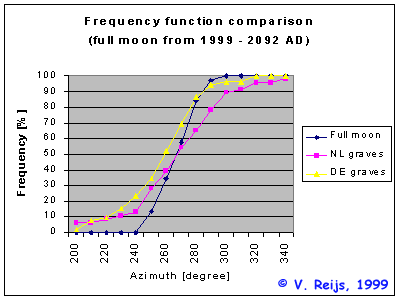
- When using the Chi-Square test (5 intervals [4 degrees of
freedom] to
keep
the number of samples per interval > 5) for both the NL and the DE
passage
mounds the hypothesis (that the distribution of azimuths of the passage
mounds is equal to the full moons azimuths around equinox) is rejected
(99%).
Other possible explanations
- Other locations where
similar
alignments
are found at Armenoi, Crete
- Dig mound by eye (Keith Pickering)
How about:
- Ancient cultural requirement to orient mound passage E-W for
religious
reasons;
- But (unlike our own culture) little cultural interest in
actually
measuring
things.
- So you dig the mound with an east-west orientation, as
determined
roughly
by eye.
About 25 degrees of scatter seems about right.
Remark VR: Could be indeed. - The orientation could be
towards any planet, because any
planet/moon on
the ecliptic gives the same orientation variation as shown above.
Remark VR: Not true, there is still this +/-25° distribution.
So equinox itself was important. Furthermore I think the moon is more
important
in most cultures then e.g. Venus or Jupiter. And full moon is a very
distinct
feature in the sky, which has been an important factor in a lot of
cultures.
Spliced stones
Like mentioned by several people (Bom, F.
and
Bakker,
J.A.), some stones seems to be spliced. Some good examples are cover
stones 1 with 2 and 3 with 4 of D25 and cover
stones 1 with 2 of D29.
Spliced stones at D25
Here are two examples of the splitting:
- cover stones 1 and 2
A lot of points on cover stones 1 and 2 provide evidence of the
splitting.
One of these evidences can be seen in the below pictures.
The scale and angle of the two pictures is different! Furthermore:
the brownish is the flat face of the stone while the greenish part is
the
vertical step.
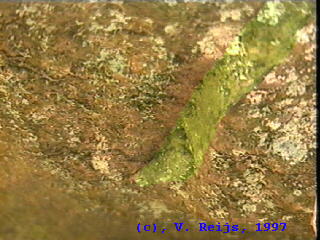
A step in the underside of cover stone 1

A step in the underside of cover stone 2
- cover stones 3 and 4
First we see two pictures of a three sided pyramid on the undersides
of cover stone 3 and 4. On stone 3 the pyramid comes out of the stone
and
at cover stone 4 is thus goes inward.

Outward 3 sided pyramid on cover stone 3
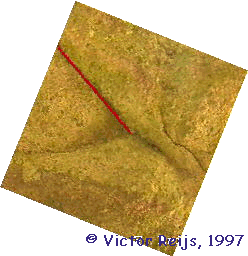
Inward 3 sided pyramid on cover stone 4
In the following picture one sees the superposition of the two
pictures:
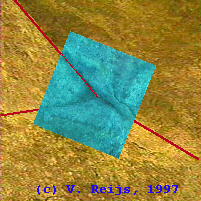
Superposition of pyramid 3 (brownish) with pyramid 4 (bluish)
Spliced stones at D29
The geometry of the undersides of cover stones 1 (blue) and 2 (red)
(error
in length around 2%):

More specific geometry info:
| side |
stone 1 |
stone 2 |
| # |
[mm] |
[mm] |
| 1 |
1200 |
1100 |
| 2 |
1700 |
1750 |
| 3 |
1000 |
1140 |
| 4 |
2000 |
1800 |
| 5 |
700 |
860 |
| 6 |
1660 |
1700 |
|
==== |
==== |
| Total |
8260 |
8350 |
Possible methods to split stones
There are some ideas how people could have spliced megalithic stones
(of
granite, gneiss, etc.):
- just by coincidence (perhaps because of frost/water/etc.). An
example
has
been seen in Ireland, Co. Wicklow.
- people pushed them over a hill lock. There are not many of them
in The
Netherlands;-), so this I would rule this out.
- They used fire. An even split could be made by put a burnable
string of
some material (palm e.g.) around the rock, burn this material and then
pour water over it. The stone could split just a the 'circle' where the
material was.
- they used wooden pegs to split the stone (like we still do with
iron
pegs).
Would that be feasible on gneiss and granite?
- usage of wooden poles in round holes. By making the poles wet,
the
stone
splits (practice in Greece and Italy).
- use little interstices, filling them with water, and allowing
them to
crack
due to frost (with the aid of wooden poles and so on).
- by laser, but I don't think the people at that time will have had
this
and the surface is not regular enough to support this.
- using cleavage, which is a predictable way splitting
occurs. At
least it was predictable to the ancient masons. It may be relevant to
recall
the Danish scientist Steno who, in the 1600's announced the 'law of
constancy
of interfacial angles', which observed that no matter how large or
small,
narrow or thick, the angles of quartz prism faces remained constant...
always 60 degrees.
- The slight variations observed on sites just 50m away from one
another
indicates a "processional " and that the event was "probably" tracked
on
foot between sites by the people who built them (Dutch Neolithic Beaker
culture) so that the entire sunrise and possibly sunset and (as
here
suggested) full moon or even eclipse track could be observed, prayed
to,
offered to, worshipped etc. The sequence would depend upon which end
allows
the aperture (opening).
- your idea! Please send them to me!
Links to other sites
Disclaimer and Copyright
 Home
Home Up
Up Search
Search Mail
Mail
Last content related changes: Aug. 24, 2000








